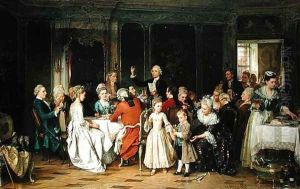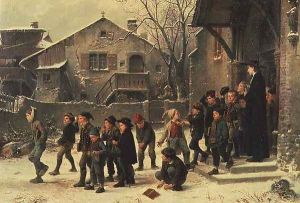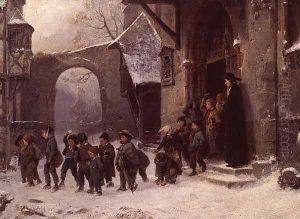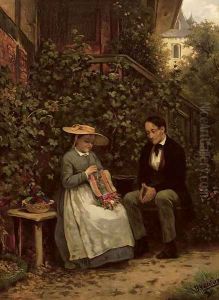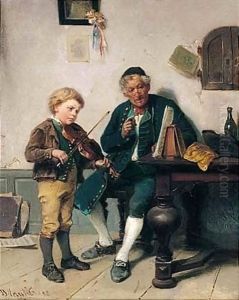Marc Louis Benjamin Vautier Paintings
Marc Louis Benjamin Vautier, commonly known as Benjamin Vautier, was a Swiss genre painter born on April 15, 1829, in Morges, Switzerland. He is often associated with the Düsseldorf school of painting. Vautier showed an affinity for the arts at a young age and initially pursued his artistic education in Switzerland. In his early twenties, he moved to Düsseldorf, Germany, which was a major art center in the 19th century, to further his studies and work. There, he became a student of the prominent painter Karl Ferdinand Sohn and later, of the influential history painter Wilhelm von Schadow, who was the director of the Düsseldorf Academy at the time.
During his time in Düsseldorf, Vautier developed a style characterized by detailed and realistic depictions of everyday life, with a particular emphasis on Swiss genre scenes. He was deeply influenced by the Biedermeier movement, which is reflected in his focus on the lives of the bourgeoisie and peasantry. His paintings often contained a moral narrative or a satirical edge, capturing the traditions, customs, and domestic lives of his subjects with warmth and humor.
Vautier gained recognition for his work, and his paintings were exhibited throughout Europe, including at the Paris Salon, where he received a second-class medal in 1859. His works were highly sought after by collectors and contributed to the growing interest in genre painting during the period. He also participated in various exhibitions in Munich, Berlin, and Dresden.
In 1866, Vautier married Margaretha Schroeder and they had three children. His family life and the people he encountered in the Swiss countryside continued to inspire his work. Vautier remained active as a painter throughout his life, and his later works continued to exhibit the same careful attention to detail and narrative quality that marked his earlier pieces.
Benjamin Vautier's contribution to Swiss and genre painting was significant, and his works can be found in many museums and private collections around the world. He was not only a painter but also a teacher, sharing his skills with a number of students. Vautier died on January 28, 1898, in Düsseldorf, leaving behind a legacy of art that captures the spirit and culture of 19th-century Swiss life.
